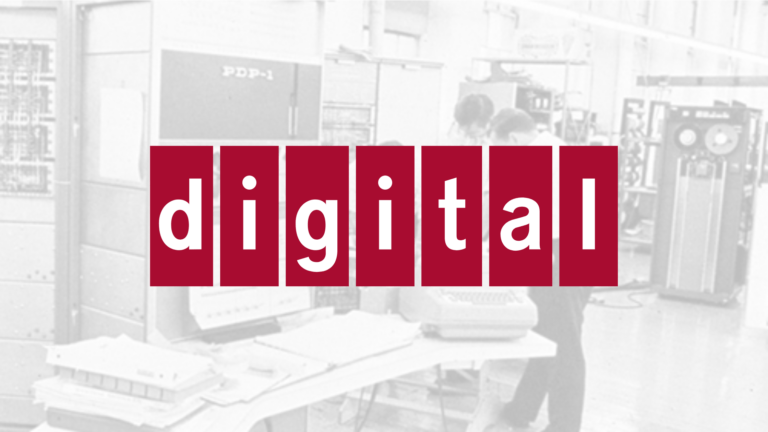In the late 20th century, Digital Equipment Corporation (DEC) played a pivotal role in shaping the landscape of computing. Founded in 1957 by Ken Olsen and Harlan Anderson, DEC started as a small startup in a nondescript mill building in Maynard, Massachusetts.
However, it quickly became a powerhouse in the world of minicomputers.
Its PDP series, starting with the PDP-1, gained popularity for their reliability and innovation. The iconic PDP-11, introduced in the early 1970s, became one of the most successful and influential minicomputers of its time. DEC’s VAX (Virtual Address eXtension) architecture, introduced in the late 1970s, further solidified the company’s position as a leader in the industry.
As the years went by, DEC’s headquarters in Maynard buzzed with innovative activities. The company had a unique culture – a mix of innovation, camaraderie, and a commitment to excellence. Engineers and developers at DEC were passionate about their work, often pushing the boundaries of what was thought possible in the realm of computing.
Between 1960 and 1970, DEC grew from a local computer company with 117 employees and $1.3 million in revenue into a global company with 5,800 workers generating $135 million in sales.
This is why DEC was known for its strong focus on research and development and software standards, which made its systems widely used in businesses, universities, and government institutions.
The distinctive humming sound of DEC’s computers became synonymous with progress, computation, and the digital age.
But soon it all came crashing down!
Related Read: Business Innovation: The What, Why, How, and Where
Why did Digital Equipment Corporation fail?
As the 1980s unfolded, so did the computing landscape. Personal computers and workstations were gaining popularity, and the industry was evolving rapidly. DEC, under the leadership of Ken Olsen, found itself hesitant to embrace the changing tide. The company’s focus on minicomputers, while successful for a time, became a vulnerability as the demand for smaller and more affordable systems grew.
Let’s go piece by piece.
Failure to Adapt to Changing Trends
Personal computers were a curiosity in the 1970s. After Apple’s successful introduction of the Apple II, IBM unveiled the IBM PC personal computer in 1981. After Microsoft’s software operating system became broadly accessible, the market for PC clones exploded.
In the late 1980s, when the business microcomputer was introduced, Ken Olsen was the CEO of Digital Equipment Corporation. Even though DEC was known for its minicomputers, such as the PDP series, which were popular in the 1960s and 1970s, it attempted to penetrate the microcomputer market.
DEC did so too, by introducing its innovative product, Rainbow, but it failed to gain the customer’s attention.
The company was slow to transition to smaller, more affordable systems, and this failure to adapt to new market demands contributed to its decline. On top of it, the business continued to heavily engage in the declining minicomputer market. Digital Equipment Corporation, as well as Ken Olsen, failed to understand the significance of microcomputers until it was far too late.
Leadership Issues
DEC had a series of leadership changes that may have impacted its ability to navigate the rapidly evolving technology landscape. Ken Olsen, one of the founders and long-time leaders of DEC, was known for resisting certain industry trends, including the shift towards personal computers. This resistance may have hindered the company’s ability to make timely strategic decisions.
In an attempt to reverse the company’s fortunes, DEC underwent leadership changes. Robert Palmer took over as CEO, and the company initiated a restructuring plan to cut costs and streamline operations.
Related Read: The CIO’s Role in Innovation: 2023 Edition
Competition from IBM and Others
DEC faced intense competition from other major players in the industry, including IBM. IBM’s dominance in the market, coupled with aggressive competition from other emerging companies, made it difficult for DEC to maintain its market share.
To compete with IBM, DEC introduced the VAX (“Virtual Address eXtension”) line of 32-bit “superminicomputers” in 1978. The VAX line was intended to be an “IBM killer” since it was more affordable, had more capacity, and was smaller than IBM’s larger computers.
However, DEC subsequently attempted to protect its VAX system by discontinuing support for open architecture, which did not attract faithful customers. Such a decision contributed to the company’s demise.
DEC also made several missteps. For example, DEC had decided to compete with IBM in the data centre market, which needed significant investments in locations, equipment, and employees.
Furthermore, DEC’s vertical integration strategy to produce all computer components itself made it challenging to compete with more innovative challengers.
Public Statement Gone Wrong
DEC’s public reputation suffered after a statement made by the company’s CEO was misinterpreted. During a session at a 1977 meeting of the World Future Society in Boston, the CEO of DEC, Ken Olsen, reportedly stated he saw “no reason for any individual to have a computer in his home,” That statement was publicized quite widely when Time magazine repeated it.
However, the repetition by The Time Magazine misled consumers because the magazine did not convey that the CEO used “computer in his home” in a very different meaning than users would currently use it.
The “computer” Ken Olsen was referring to (and rejecting as a home consumer product) in 1977 was not the modern PC. It was a desktop user-driven device many consumers used to play games, send and receive an e-mail, store photographs, and manage the family budget.
Olsen later stated that he was already well aware of the potential for such individual-driven applications of a home-based computer.
According to the CEO, “[That interpretation of my comment] is, of course, ridiculous because the business we were in was making PCs, and almost from the start I had them at home and my wife played Scrabble with time-sharing machines, and my sixth-grade son was networking the MIT computers and the DEC computers together, hopefully without doing mischief, using the computers I had at home. Home computers were a natural continuum of the “personal computers” that people had at work, in the laboratory, in the military.”
Financial Challenges
DEC experienced financial difficulties, including declining revenues and profitability. The company faced challenges in managing costs and generating sufficient revenue to sustain its operations.
Facing ongoing challenges, DEC was acquired by Compaq in a deal valued at about $9.6 billion. Compaq, at the time, was a major player in the personal computer market. The acquisition aimed to strengthen Compaq’s position in enterprise computing and services.
However, in 2002, Compaq merged with HP. And DEC’s assets became part of Hewlett-Packard (HP) too.
The integration of DEC’s technologies and personnel into Compaq and later HP faced challenges. Cultural differences, product integration issues, and changes in management contributed to a complex transition.
End of the DEC Brand
DEC made some strategic errors, such as betting heavily on the VAX architecture while overlooking the potential of the emerging RISC (Reduced Instruction Set Computing) architecture. This misjudgment further contributed to DEC’s decline as RISC architectures gained popularity.
After the acquisition, the DEC brand gradually faded away. Products and technologies associated with DEC were either discontinued or integrated into HP’s product lineup. The acquisition marked the end of DEC as an independent entity.
What could have saved DEC?
Saving Digital Equipment Corporation (DEC) would have required a combination of strategic decisions, adaptability to market changes, and effective management. Most of all, continuous innovation.
Adaptation to Changing Trends
DEC could have moved more quickly into the personal computer market, recognizing the rising demand for smaller, more affordable computing solutions. It was already known for proprietary architectures. Embracing open systems and industry standards could have helped the company stay relevant in a rapidly evolving market.
Innovation and Diversification
Investing in research and development to innovate new products and technologies could have helped DEC maintain a competitive edge. Diversifying its product portfolio beyond minicomputers into emerging markets, such as networking or storage solutions, could have provided new revenue streams.
Related Read: How to build an innovation strategy?
Strategic Partnerships and Alliances
Forming strategic partnerships or alliances with other tech companies could have provided DEC with additional resources, expertise, and market access to compete more effectively.
Effective Leadership
DEC desperately needed a leadership that was more adaptable to market changes and willing to make bold decisions. It could have helped DEC navigate the industry’s transformation.
Avoiding a resistance to industry trends and embracing a more forward-thinking approach.
Cost Management
DEC could have implemented effective cost-cutting measures and operational efficiencies to address financial challenges. This would have improved the company’s financial health.
Customer Relationship Management
Strengthening customer relationships and understanding their evolving needs could have helped DEC. They could have better tailor its products and services to the market demand.
Related Tip: Idea Assist
In Conclusion
Digital Equipment Corporation posted its first full-year loss in 1991. Ken Olsen quit as CEO in 1992. The company experienced losses in the next few years. Intel Corp. purchased DEC’s microprocessor manufacturing facility in 1997. Finally, COMPAQ Computer Corp. acquired Digital Equipment Corporation in 1998 for $9.6 billion.



